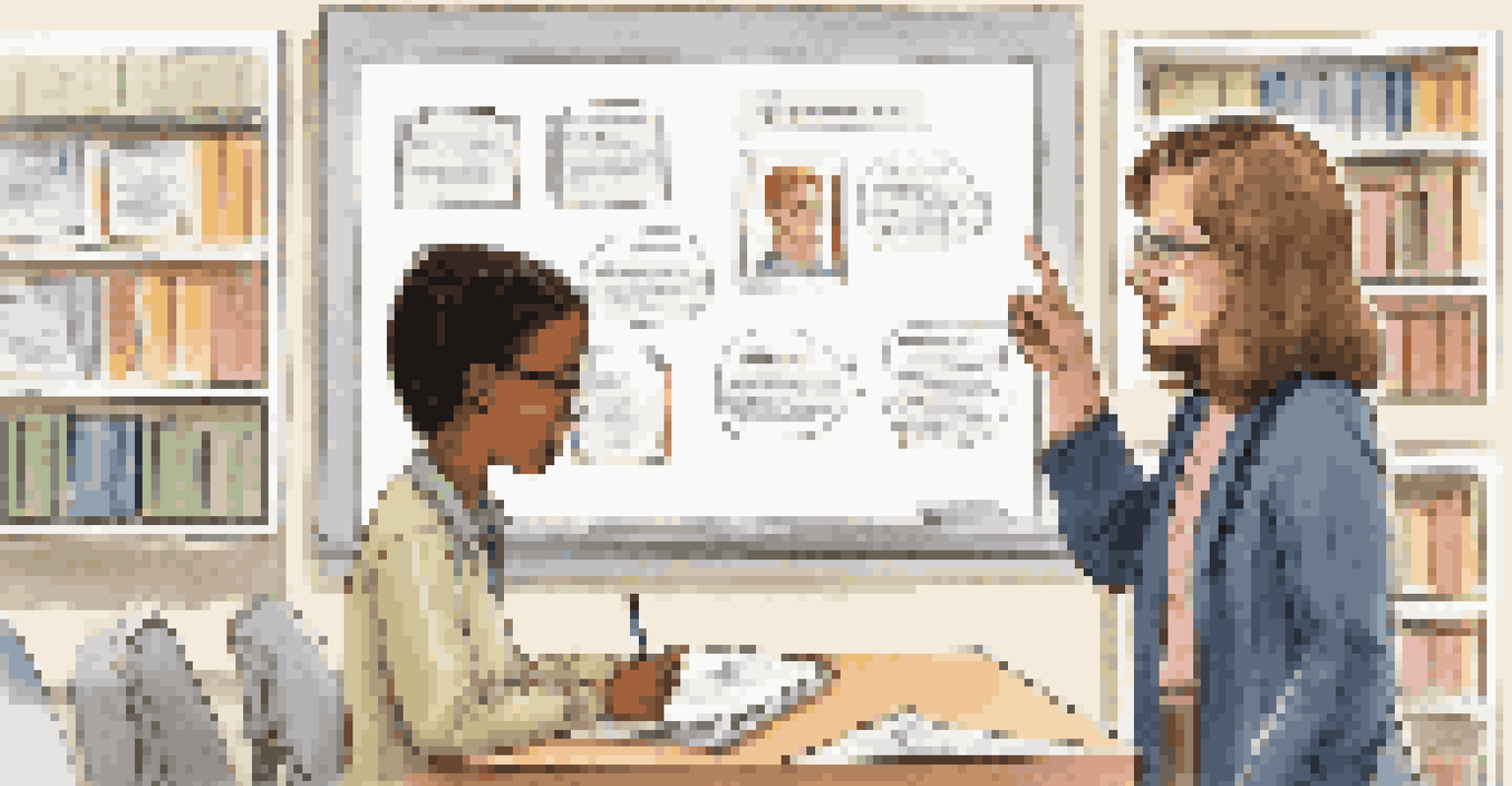Utilizing Blended Assessments to Enhance Student Learning Outcomes

Understanding Blended Assessments and Their Importance
Blended assessments combine traditional testing with alternative evaluation methods, such as projects and presentations. This approach caters to various learning styles and allows students to demonstrate their understanding in diverse ways. By integrating both formative and summative assessments, educators can create a more holistic view of student performance.
The greatest use of a life is to spend it on something that will outlast it.
For instance, while a written exam may assess theoretical knowledge, a project can showcase practical application. This dual approach can be particularly beneficial for students who may excel in hands-on tasks but struggle with standard testing formats. Consequently, it fosters a more inclusive environment that values different strengths.
Moreover, blended assessments encourage continuous feedback, enabling students to learn from their mistakes and improve over time. This iterative process not only enhances learning outcomes but also builds student confidence, making them more engaged and motivated in their educational journey.
Designing Effective Blended Assessments
Creating successful blended assessments starts with clear learning objectives. Educators should identify what students need to learn and determine the best methods to evaluate that knowledge. By aligning assessments with specific goals, teachers can ensure that both components—traditional and alternative—work together seamlessly.

For example, if a goal is to develop critical thinking, a teacher might pair a multiple-choice quiz with a group discussion. This combination not only tests students' recall but also assesses their ability to articulate and defend their ideas. The key is to design assessments that complement each other and provide a comprehensive view of student understanding.
Blended Assessments Enhance Learning
Combining traditional tests with projects allows students to showcase their knowledge in diverse ways, catering to various learning styles.
Additionally, incorporating technology can enhance the assessment experience. Online platforms can facilitate peer reviews or digital portfolios, allowing for greater flexibility and accessibility. By leveraging technology, educators can create a more dynamic and engaging assessment process that resonates with today's learners.
The Role of Feedback in Blended Assessments
Feedback is crucial in blended assessments, as it guides students in their learning journey. Timely and constructive feedback helps learners understand their strengths and areas for improvement, fostering a growth mindset. This can be particularly impactful when assessments are designed to be reflective and iterative.
Education is not the filling of a pail, but the lighting of a fire.
For instance, after a project is submitted, students can receive feedback not only on the final product but also on their process and collaboration skills. This comprehensive feedback encourages students to reflect on their learning and apply suggestions in future tasks. By emphasizing the importance of feedback, educators can help students see assessments as opportunities for growth rather than just a means to an end.
Moreover, incorporating peer feedback can empower students and enhance their critical thinking skills. When students evaluate each other's work, they engage in higher-order thinking and learn to appreciate diverse perspectives. This collaborative approach not only enriches the learning experience but also builds a supportive classroom community.
Adapting Blended Assessments for Diverse Learners
One of the greatest advantages of blended assessments is their adaptability for diverse learners. By offering multiple assessment methods, educators can cater to various learning preferences and abilities. This flexibility ensures that all students have the opportunity to demonstrate their knowledge in a way that suits them best.
For instance, visual learners may benefit from projects that incorporate graphics or presentations, while auditory learners might excel in discussions or oral exams. By recognizing these differences, teachers can create a more equitable assessment environment that fosters success for everyone. This approach not only promotes inclusivity but also helps to build a positive learning culture.
Feedback Drives Student Growth
Timely and constructive feedback in blended assessments helps students understand their strengths and areas for improvement, fostering a growth mindset.
Additionally, providing options within assessments—such as choosing between a written report or a creative project—can empower students. This sense of choice enhances motivation and engagement, as learners feel more invested in their educational experience. Ultimately, adapting assessments to meet diverse needs can significantly enhance overall learning outcomes.
Challenges of Implementing Blended Assessments
While blended assessments offer many benefits, they also come with challenges that educators must navigate. One common hurdle is the time required to develop and implement these assessments effectively. Creating diverse evaluation methods can be time-consuming, especially for busy teachers managing multiple classes.
Another challenge is ensuring consistency in grading, particularly when subjective elements are involved in assessments like projects or presentations. Establishing clear rubrics and criteria can help alleviate this issue, providing transparency and fairness in evaluation. This consistency is essential to maintain credibility and trust in the assessment process.
Finally, educators may face resistance from students or parents who are accustomed to traditional assessment methods. It’s important to communicate the rationale behind blended assessments and highlight their benefits. By fostering an open dialogue, teachers can help stakeholders understand the value of this innovative approach to student learning.
Measuring the Impact of Blended Assessments
To determine the effectiveness of blended assessments, educators must establish metrics for measuring student learning outcomes. This can include analyzing test scores, project evaluations, and student engagement indicators. By collecting and analyzing data, teachers can gain insights into how well blended assessments are supporting student learning.
For instance, comparing pre- and post-assessment results can reveal improvement in specific areas, guiding future instruction. Additionally, gathering student feedback on their assessment experiences can provide valuable perspective on what works and what doesn’t. This information can help educators refine their approach and enhance the overall effectiveness of their blended assessment strategies.
Adaptability for Diverse Learners
Blended assessments provide multiple methods of evaluation, ensuring all students can demonstrate their knowledge in ways that suit their learning preferences.
Moreover, sharing successful practices and outcomes with colleagues can foster a culture of continuous improvement. Collaboration among educators can lead to innovative ideas and strategies that benefit all students. By measuring and sharing the impact of blended assessments, educators can build a strong case for their continued use in the classroom.
Future Trends in Blended Assessments
As education evolves, so too will the methods of assessment. The future of blended assessments is likely to incorporate even more technology and personalization. With advancements in artificial intelligence, educators may be able to tailor assessments to individual student needs and learning paths, creating a truly customized learning experience.
Additionally, the rise of online learning platforms opens up new avenues for blended assessments. Virtual environments can facilitate collaboration and creativity, allowing students to engage in assessments that transcend traditional boundaries. This shift not only enhances accessibility but also prepares students for the increasingly digital world.

Moreover, as the emphasis on social-emotional learning grows, blended assessments may increasingly include components that evaluate collaboration and communication skills. This holistic approach will ensure that students are not only academically prepared but also equipped with the interpersonal skills necessary for success in the future.